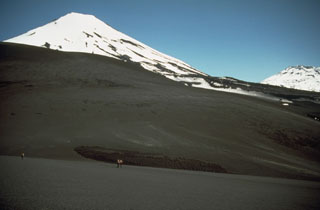Report on Lonquimay (Chile) — August 1989
Scientific Event Alert Network Bulletin, vol. 14, no. 8 (August 1989)
Managing Editor: Lindsay McClelland.
Lonquimay (Chile) Moderate explosive activity and lava production continue
Please cite this report as:
Global Volcanism Program, 1989. Report on Lonquimay (Chile) (McClelland, L., ed.). Scientific Event Alert Network Bulletin, 14:8. Smithsonian Institution. https://doi.org/10.5479/si.GVP.SEAN198908-357100
Lonquimay
Chile
38.379°S, 71.586°W; summit elev. 2832 m
All times are local (unless otherwise noted)
The eruption was continuing from Navidad Cone on 10 August. Some crumbling of the cone had recently occurred. At the cone's E base were 2-3 active vents, with the central vent continuously active. The eruption column varied in height from 1,500 to 1,800 m above the crater, feeding a lead-colored plume that was carried E over the Lonquimay district by the wind. The lava flow's longer lobe, which extends ~10 km NE down the Lolco River valley, was continuing to advance, but the shorter Laguna Verde lobe that extends N from the cone had stopped moving.
Geological Summary. Lonquimay is a small, flat-topped, symmetrical stratovolcano of late-Pleistocene to dominantly Holocene age immediately SE of Tolguaca volcano. A glacier fills its summit crater and flows down the S flank. It is dominantly andesitic, but basalt and dacite are also found. The prominent NE-SW Cordón Fissural Oriental fissure zone cuts across the entire volcano. A series of NE-flank vents and scoria cones were built along an E-W fissure, some of which have been the source of voluminous lava flows, including those during 1887-90 and 1988-90, that extended out to 10 km.
Information Contacts: G. Fuentealba and P. Riffo, Univ de la Frontera.

